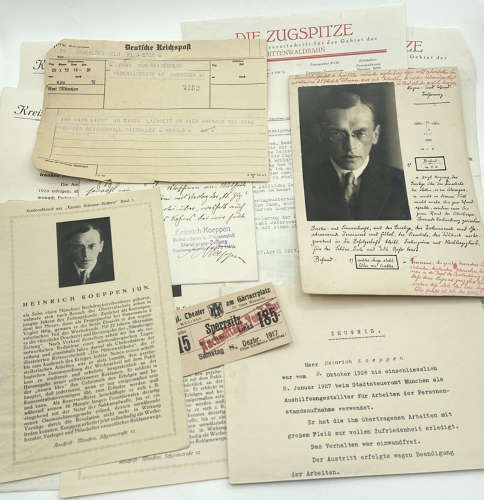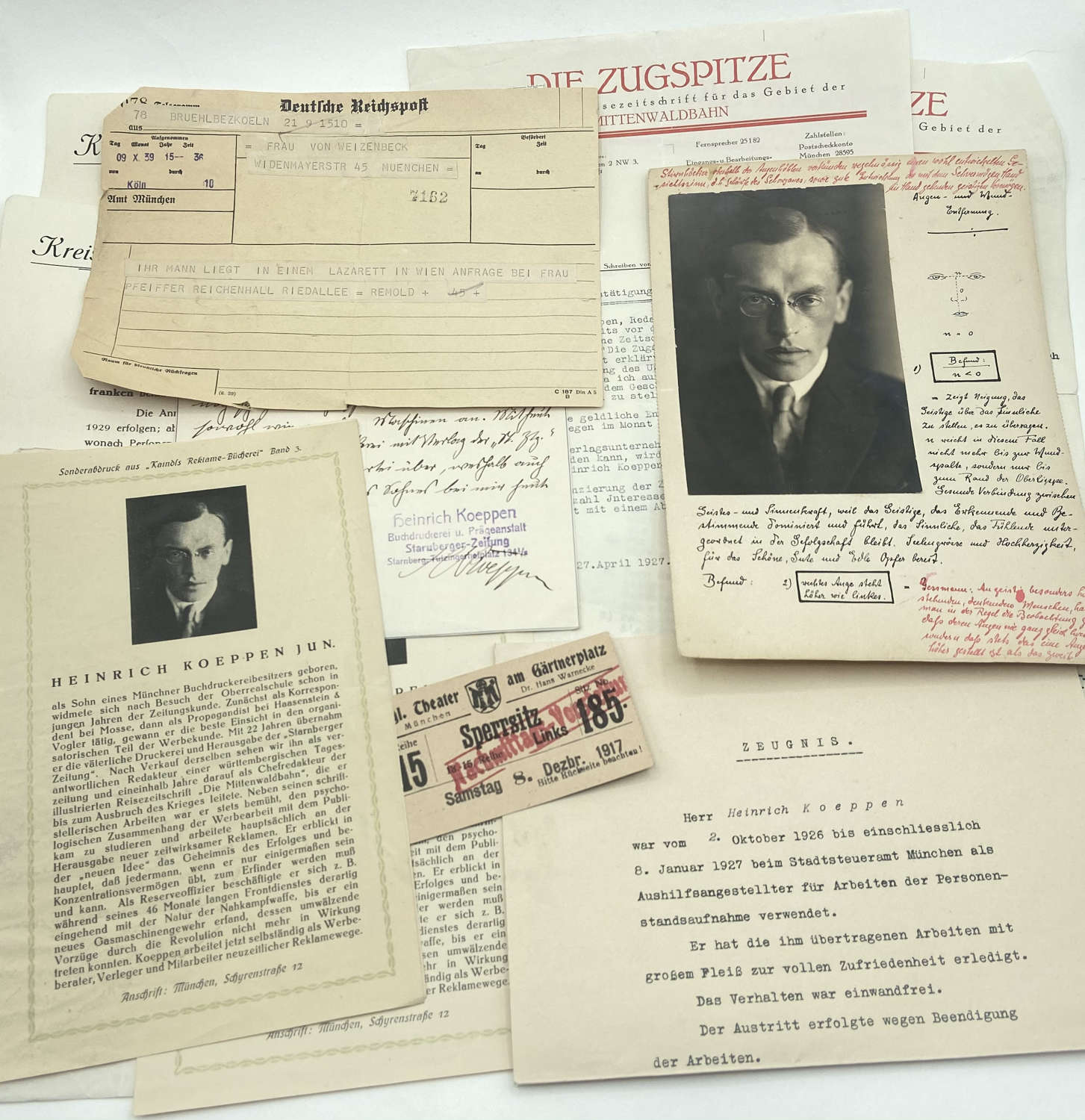
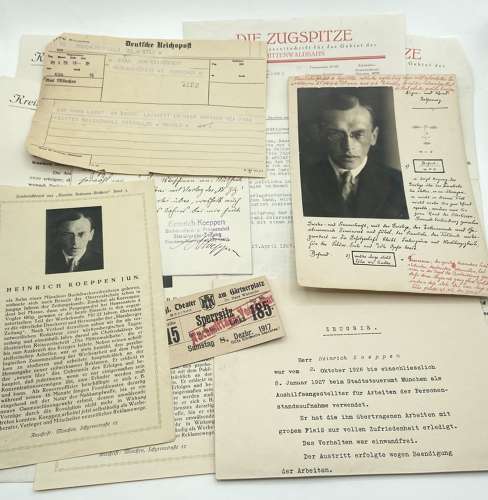
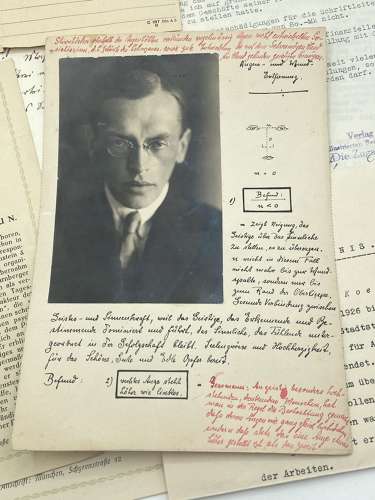
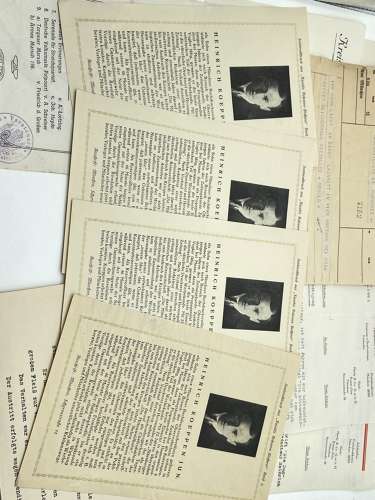
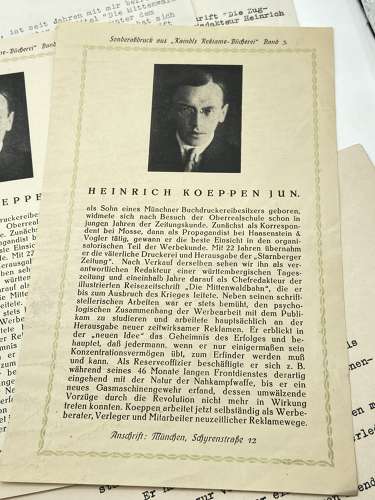
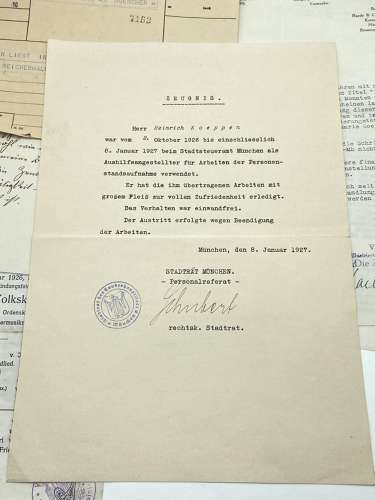
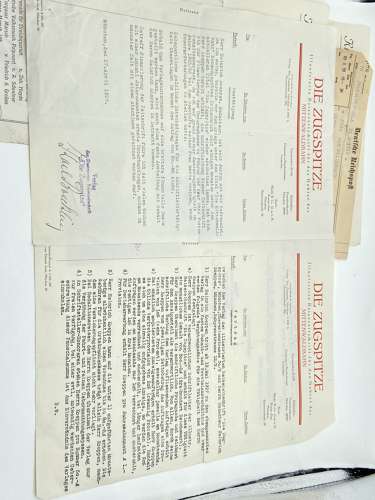
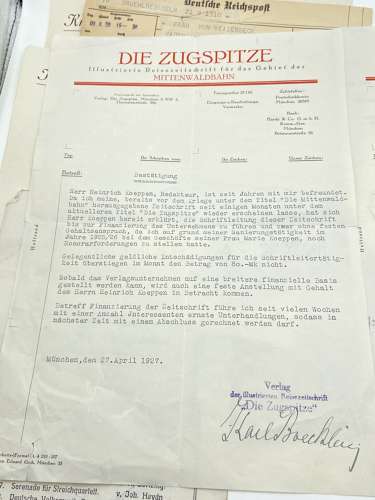
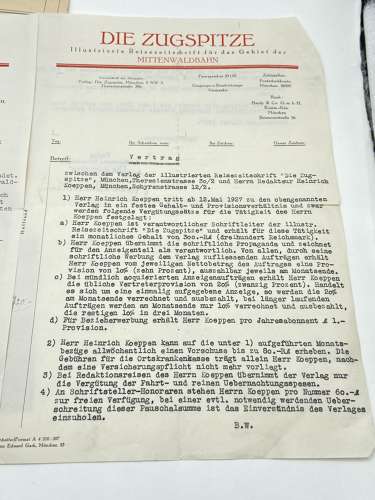
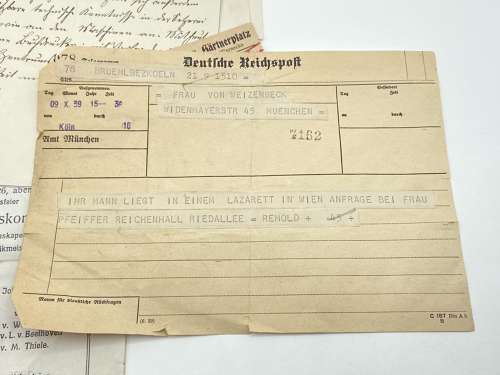
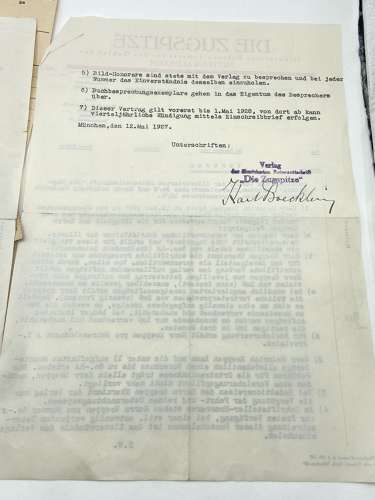
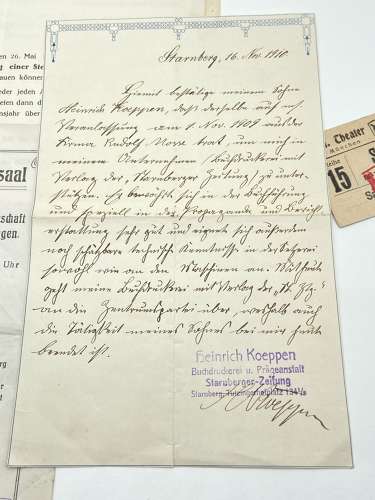

WW2 SS Deutschland Obersturmführer Heinrich Koeppen Group KIA 1939
Code: 12322
(1 in stock)
For sale is an extraordinary WW2 SS Germania Commander 3rd Battalion Heinrich Koeppen KIA 1939 Ukraine Grouping including details of the final battle that led to his death and lieutenant Weizenbeck being serious wounded in 1939.
In this grouping is an extremely rare one if a kind telegram from lieutenant Weizenbeck in a hospital in Vienna alerting his wife to the situation. In which the telegram translates to “Her husband is in a hospital in Vienna. Inquiry with Mrs. Pfeiffer Reichenhall Riedallee = Remold. Ms Von Weizenbeck Widenmayerstrasse 45 Munich.”
History Surrounding The Death Of Koeppen & Wounded Lieutenant Weizenbeck:
15.09.1939 parts of 'Germania' attached to 2. LeichtDiv. stationed at Przylbice, Muzylowice, Mogila and Czarnokonce villages and were given task to close the roads leading east and prevent Polish troops of 'Karpaty' Army from reaching Lvov.
I found out, that Muzylowice (inhabited mostly by German colonists) was occupied by:
- regiment's HQ,
- 3rd. battalion,
- support subunits.
At night Muzylowice was attacked by Polish 49. IR (called 'Huculski' or 'Strzelców Kresowych' = 'Border Rifles') of 11. Carpathian ID, led by LtCol. Hodała. Poles went into battle with their rifles unloaded. Germans were caught completely by surprise and suffered heavy casualties. Commander of III battalion SS-Obersturmbannführer Koeppen and regiment's aide-de-camp SS-Obersturmführer Schomburgwas were killed in hand-to-hand combat. Regiment's HQ fled to Jaworow (some 10 km N of Muzylowice). Moreover the unit lost almost all of its heavy equpment, including 8 howitzers 10,5 cm, AA guns battery, majority of mortars and HMGs plus all vehicles.
Nevertheless, III batallion rallied quite quickly and since 17.09.1939 was used to cover flank of XVII Korps.
Koeppen and 22 other men of III./"Germania" were killed that day
Fighting between Polish 49. IR and SS-Standarte 'Germania' started already in the afternoon 15.09.1939. Standarte withdrew to line Przylbice, Muzylowice, Mogila and Czarnokonce.
Night attack of 15/16.09.1939 started at ca. 9 pm. Muzylowice and Mogila was attacked by 49. IR (11. ID). I battalion of 98. IR (38. Reserve ID) attacked Czarnokonce shortly before midnight and captured it after heavy fighting. There the Polish captured 60 motorcycles with MGs on sidecars, three batteries of artillery, 12 anti-tank guns, over a dozen combat vehicles and tens of lorries with ammunition. When the battalion moved further Czarnokonce was reoccupied by Germans and had to be assaulted again by III battalion of 53. IR (11. ID).
With the XXII Pz K. (XXII Pz K KTB).
11 Sep 1939: The SS Germania should be attached to the Corps on Sep 12.
13 Sep 1939: The SS Germania (less one Battalion) was at 05:30 hours at the west exit of Jaroslaw and advancing via Wysocko - Krakowiec reached its defensive positions east and southeast of Jaroslaw at 15:30 hours without enemy contact.
At 15:00 hours one Kradsch.company (15./ SS Germania) sent towards Sadowa Wisznia to block there the main road Przemysl - Lemberg captured one Polish battalion (around 500 men).
14 Sep 1939: At dawn the SS Germania informed via one orderly Officer that the Kradsch company deployed at Sadowa Wisznia was counterattacked at dusk and had to retreat towards north with great number of casualties. great part of the enemy troops were moving from Przemysl to Lemberg.
At 06:00 hours the Corps order that the road was to be blocked by fire. All the SS Regiment was to move to Sadowa Wisznia urgent. ARKO 30 sent the III./ AR 109 (less 10 cm battery) to Jawarow.
At 16:00 hours the II./ SS Germania was advancing towards Oleszicze.
15 Sep 1939: 03:00 hours the ARKO 30 informed about the fights of the SS Germania at Jaworow.
At 06:00 hours one strong attack north of Bortiatyn broke through the SS Regiment. Parts of the motorized Advance guard of the XVII AK joined with the SS Gerrmania.
The 1 GD could block the road at Grodek Jagiellonski.
At 22:40 hours Arko 30 informed about a strong attack against the SS Germania at Jaworow. The III./ SS Germania retreat towards the line Mogila - height north of Tuczapy. The II./ SS Germania and the 2. and 3./SS Germania were sent urgent to Jawarow north under XVII AK orders.
16 Sep 1939: At 02:10 hours the SS Germania informed that due to superior enemy had to give ground to the north. located at the south edge of Jaworow.
SS Germania was to be under XVIII AK orders from 17 Sep onwards.
The map taken from: Klęska SS-Standarte "Germania"
w relacji płk. dypl. Bronisława Prugara-Ketlinga.
Leutnant Frobenius
Those weren’t only clouds, which were flowed, together ascended smoke columns over the area of Grodek-Jagiellonski – Dobrostany – Hartfeld – Sadowa-Wisnia, where since three days a embittered battle was in course.
The Division of Munich drove the remnants of the Polish divisions back, those that had advanced fiercely against a SS-Standarte at Jawarow. However, the forest gave the poles the possibility to gather their striking force again and again so they could press against the, under extreme strain, gebirgsjägers deployed at Grodek and Dobrostany.
Our bombers attacked the enemy rear disturbing them so they shifted the efforts northwards on the wooded land of Janow-Jaryna. But the barriers held – our casualties weren’t small however – among others the Division’s Staff lost Leutnant Frobenius, an editor of a Munich newspaper, which fell at Dobrostany. Leutnant von Weizenbeck was severely wounded.
“I have a especial task”, said to us Leutnant Frobenius full of joy. At 01:00 o’clock (17 Sep 1939) he drove away in the night wit his special job towards Dobrostany. His departure was in good mood. Now, he followed his father, who fell in 1914, into the soldier’s death; a granade’s splinter struck through his steel helmet.
Full story:
The day and night-long battle of Hartfeld was the first battle of Polish 97. Reserve Infantry Regiment from 38. Reserve ID since the beginning of war - a completely inexperienced Polish reserve infantry won the battle thanks to the bravery of exhausted by withdrawal marches and hungry soldiers, but suffered huge casualties - mainly due to the German terrific artillery fire, huge firepower superiority and Luftwaffe bombings:
"[...] Soldiers were exhausted and in terrible moods. Around midday [on 15.09.1939] during a strong German air bombing, a briefing of high commanders took place in Sadowa Wisznia.
Account of lieutenant colonel T. Walich concerning the AA defence of Sadowa Wisznia in period 14.09.1939 - 15.09.1939 [it was defended by one Reserve AA MG company]:
"during bombings, when enemy planes were going down even up to 30 metres above the ground, any MG staff did not leave its post, fireing to the end. Commander of this company as well as its soldiers, deserve the greatest recognition"
During the briefing general Kazimierz Sosnkowski discussed the situation and variants of further operations. Reports from 38. Reserve ID and 11. ID said, that along the Wereszyca river, near Grodek Jagiellonski and Kamienobrod, a powerful German barrier was detected, with strong bridgeheads on the western bank of the river along the line from the south to the north across Bratkowice, Burgthal, Haliczanow, Hartfeld, hill 317 "Turecka Mogila" and a little bit weaker garrisons along the line: Tuczapy, Czarnokonce, Muzylowice, Ozomla, Rogozno, Jaworow.
Possibility of being encircled by the enemy seemed to be the lowest from the southern side.
Three variants of operations were considered:
- crossing the Wereszyca river and march along the shortest road towards Lwow
- march to the north towards Jaworow for the purpose of connecting with Army "Cracow" under command of general Antoni Szylling
- march to the south across Komarno and later behind the Dniestr river, to the Romanian Bridgehead
[...]
The decision was made to march to the north-east and to break through the Janowskie Forests to Lwow.
[...]
Divisions received the following orders:
- 11. ID under command of colonel Bronisław Prugar-Ketling will assault in north-eastern direction and will seize the Janowskie Forests in the area of localities Szklo and Moloszkowice, where it will take the defensive positions facing the western and south-western directions. 11. Heavy Artillery Unit [Polish: Dywizjon] under command of major Zygmunt Dobrowolski, which was advancing with 38. Division so far, is attached to the division.
- 38. Reserve ID will conquer Dobrostany and Kamieniobrod, where it will prepare the defence from the west and from the south.
- 24. ID under command of colonel Bolesław Schwarzenberg-Czerny will advance in the second stage, behind 11. ID.
[...]
At 16:45 [on 15.09.1939] 1st battalion of 97 IR under command of mjr. Jozef Trzesinski supported by 1/5 Heavy AR attacked Rodatycze, which were captured after the combat which lasted until the dusk. The enemy withdrew to the main defensive positions, covering himself with patrols. Behind Rodatycze near the manor-house 3rd battalion under command of major Franciszek Wrona took the lead and 1st battalion was advancing behind it. Around 23:00 III/97 was heavily fired at by artillery and machine gun fire from the locality Hartfeld, which was occupied by German Kampfgruppe "Ernst", supported by III/AR.79 under command of Oberstleutnant Bialonzig and from the hill 317 "Turecka Mogila", by Kampfgruppe "Zimmer".
In such situation major Franciszek Wrona immediately prepared his companies to the assault and after heavy combat he captured Hartfeld and Rzerzyczany, breaking through to the north-east. Especcialy fierce combats took place in the heavily filled by German soldiers cemetery located south of Hartfeld, where among numerous KIA was the commander of German III/AR.79 Oberstleutnant Bialonzig, who had got his command post there.
Also I/97 under command of mjr. Jozef Trzesinski which was advancing in the second stage joined to the assault, and also managed to break through the German barrier, but under heavy casualties.
Due to the darkness and strong fire (soldiers of the regiment for the first time were under direct fire) battalions and companies mixed, and command became much hampered.
During the battle of Hartfeld the commander of 1st MG company of 97 IR, captain Władysław Chełchowski, and around 200 riflemen [from 97. Reserve Infantry Regiment] were killed.
Commander of 2nd company was heavilly wounded, commander of 3rd company was slightly wounded, colonel St. Zielke was contused. Major J. Trzesinski, commander of 1st company of 97 IR, captain Kazimierz Zbaorszczyk, wounded commander of 3rd company and six other officers plus around 200 riflemen (mainly wounded) were captured. German casualties were also heavy, but any exact numbers are unknown."
And further combats:
"Around 4:00 on 16.09.1939 II/97 advancing on the right wing captured Bratkowice and the hill 296 located north of Bratkowice with use of its 4 company under command of captain Alfred Szmidt. Polish losses were 2 KIA, 2 heavilly and 4 slightly wounded. German casualties: 5 KIA and several wounded. 9 German soldiers were captured. On the left in the direction towards Burgthal 6 company of 97 IR under command of captain Władysław Ullman was attacking. The assault was supported by 2 MG company. But Luftwaffe bombing, heavy MG, mortar and artillery fire of German Kampfgruppe "Friedmann", supported by I/79 Geb. AR under command of Oberstleutnant Winkler and 12. heavy battery of 79. Geb. AR, made the Polish breakout in this direction impossible.
Commander of II/97 IR - who wanted to rouse his soldiers into fight with his own example - was heavilly wounded and later died. 4 company of 97 IR and 6 company of 97 IR suffered 40% casualties. Captain Alfred Szmidt was seriously wounded. In the evening on 16.09.1939 German strengthened 179. Infanterie-Regiment from 57. Infanterie-Division attacked rears of Polish II./97 IR, which was already involved in combats - as the result of this attack major part of the Polish battalion was destroyed. Only 5. company, part of 2. MG company and small group of soldiers from 6. company managed to leap aside to the north, where they joined the group commanded by colonel J. Pecka. Polish artillery, disorganized by heavy whole day-long Luftwaffe bombings, lost communication with advancing forward infantry, and did not support it at all during that combat.
Attached to 96 Reserve IR, I battalion of 98 Reserve IR attacked Czarnokonce from the locality Laszki after 23:00 on 15.09.1939. Czarnokonce were defended by units from motorized regiment SS "Germania". After around one hour of fierce combats, Czarnokonce were captured and inside the village over 60 motorycles with MG trailes, three artillery batteries, 12 AT guns, a dozen or so armoured vehicles and several dozens cars & trucks were captured. The enemy lost 50 KIA or WIA; 2 officers and 13 soldiers were captured. Polish casualties were 2 officers and 30 NCOs and soldiers KIA or WIA, including seriously wounded (later died) commander of 3 company of 98 IR lieutenant Pluta, wounded sub-lieutenant Mazurkiewicz and slightly wounded major St. Marek. Heavy Polish losses were caused by friendly fire of own MGs and mortars of 1. MG company from 98 IR under command of lieutenant Kunicki, which were fireing at Czarnokonce, and didn't know that the 3rd company had already captured this village. This fire was stopped not until the intervention of the battalion commander. After clearing the locality, the battalion marched towards Muzylowice, which were already captured by 49 infantry regiment from 11. ID. General Kazimierz Sosnkowski who was in Muzylowice, after receiving major St. Marek's report about the result of the combat, ordered him to destroy the German equipment captured in Czarnokonce. Then I/98 marched further towards Lesniowka and in the afternoon reached on 16.09.1939 reached the southern edge of the Janowskie Forests near Kertyna and Wola Dobrostanska. According to the orders it took defensive positions there with two companies (the third company in reserve) at the edge of the forest crosswise, the road from Dobrostany, closing the direction to locality Jaryna. [...]"
The other translated documents include:
A lot of four translated from German to English: Reprint from "Kainos Reklame - Bücherei" Volume 3. HEINRICH KOEPPEN JUN. Born as the son of a Munich book printer owner, after attending secondary school he devoted himself to newspaper studies at an early age. First as a correspondent at Mosse, then as a propagandist at Haasenstein & Vogler, he gained the best insight into the organizational part of the advertising customer. At the age of 22 he took over his father's printing and publishing of the "Starnberger Zeitung". After selling the same, we see him as the responsible editor of a Württemberg day. newspaper and a year and a half later as editor-in-chief of the illustrated travel magazine "Die Mittenwaldbahn", which he directed until the outbreak of war. In addition to his writing work, he always tried to study the psychological connection between advertising and the public and mainly worked on He sees in the new idea "the secret of success and claims that everyone, if he only exercises his ability to concentrate to some extent, must and can become an inventor. As a reserve officer he occupied himself e.g. For example, during his 46 months long service at the front, he studied the nature of the melee weapon so deeply that he invented a new gas machine gun, the revolutionary advantages of which could no longer take effect. Koeppen now works independently as an advertising company. consultants, publishers and employees of modern advertising channels. Address: Munich, Schyrenstrasse 12
Another letter to Heinrich Koeppen German translated to English:
TESTIMONY . was used by Mr. Heinrich Koeppen from October 1926 up to and including January 8, 1927 at the Minchen city tax office as a temporary employee for work on the survey of persons. He has done the work assigned to him with great diligence to full satisfaction. The behavior was impeccable. The resignation took place because of the completion of the work. Munich, January 8, 1927. CITY TRADING MUNICH. Personalreferat - 19015 phubert rechtssk. City council .
A letter dated 1910 written by Heinrich Koeppen and hand signed!
Another exceptionally rare document SS anatomy Card with an original portrait photograph of heinrich Koeppen attached to card with hand written notes about his anatomy, health and belief system. This document was produced by the SS in order to identify the right men for the job, men of ethnic purity and belief system.
A lot of four translated from German to English: Reprint from "Kainos Reklame - Bücherei" Volume 3. HEINRICH KOEPPEN JUN. Born as the son of a Munich book printer owner, after attending secondary school he devoted himself to newspaper studies at an early age. First as a correspondent at Mosse, then as a propagandist at Haasenstein & Vogler, he gained the best insight into the organizational part of the advertising customer. At the age of 22 he took over his father's printing and publishing of the "Starnberger Zeitung". After selling the same, we see him as the responsible editor of a Württemberg day. newspaper and a year and a half later as editor-in-chief of the illustrated travel magazine "Die Mittenwaldbahn", which he directed until the outbreak of war. In addition to his writing work, he always tried to study the psychological connection between advertising and the public and mainly worked on He sees in the new idea "the secret of success and claims that everyone, if he only exercises his ability to concentrate to some extent, must and can become an inventor. As a reserve officer he occupied himself e.g. For example, during his 46 months long service at the front, he studied the nature of the melee weapon so deeply that he invented a new gas machine gun, the revolutionary advantages of which could no longer take effect. Koeppen now works independently as an advertising company. consultants, publishers and employees of modern advertising channels. Address: Munich, Schyrenstrasse 12
Another letter to Heinrich Koeppen German translated to English:
TESTIMONY . was used by Mr. Heinrich Koeppen from October 1926 up to and including January 8, 1927 at the Minchen city tax office as a temporary employee for work on the survey of persons. He has done the work assigned to him with great diligence to full satisfaction. The behavior was impeccable. The resignation took place because of the completion of the work. Munich, January 8, 1927. CITY TRADING MUNICH. Personalreferat - 19015 phubert rechtssk. City council .
A letter dated 1910 written by Heinrich Koeppen and hand signed!
Another document with an original portrait photograph of heinrich Koeppen attached to card with hand written notes.
And a theatre ticket
Kgl. Theater am Gärtnerplatz Munich Dr. Hans Warnecke row Sitz No Sperrgitaru 185 15 13. - 15. Row left Saturday 8th Decbr. 1917 Please note the reverse!
Visit Munich's tourist attraction BRAKLS KUNSTHAUS BEETHOVENPLATZ POL LATION TE Weekdays 9 a.m. By tram 07/12 on Sundays from 10 a.m. to 1 a.m. reachable Dreisvederetasies
Another document translates to Kgl. ME Row 5drüßenhaus - Feſtsaal 15 Young German Order Brotherhood Meiningen Monday, January 18, 1926, 8 o'clock in the evening for the celebration of the founding of the Reich. German folk concert performed by the Order Orchestra. Direction: F. Liepe, senior music master a. D. 1. Faithful German. v. Joh. Blankenburg 2nd speech and Germany song. 3rd final d. 3 act from Rienzi V. R. Wagner 4. a) Adagio for cello v. W. A. Mozart b) Menuatt (Mr. Kux.) V.L. v. Beethoven 5. Our Navy. March. V. M. Thiele. 6. Fantasy memories v. A. Lorizing 7th Serenade for String Quartet. v. Joh. Haydn 8. German folk music Polpourri v. A. Schreiner 9. a) Torgauer March v. Friedrich the Elder Great b) Army March 198. first EC mm orei
Another two documents translate to District association of Oberfränkiſcher Wagner guilds Date of the pole temple At the district meeting that took place on Sunday, May 26th 1929 in Münchberg, the erection of a death hall for the district of Upper Franconia was approved; The wives can also be accepted as members. Members of all ages can register by December 31, 1929; From January 1, 1930, the articles of the statutes come into force, according to which persons who have passed the age of 50 will no longer be admitted. Former masters can also register by the above-mentioned date. Members who join after January 1, 1930 receive only half of the death benefit in the event of death in the first 3 years. District Association of Oberfränkiſcher Wagner Guilds Date of the Poſtſtempel At the district meeting that took place on Sunday, May 26th 1929 in Münchberg, the establishment of a death coffeehouse for the district of Upper Franconia was approved; The wives can also be accepted as members. Members of all ages can register by December 31, 1929; From January 1, 1930, the articles of the statutes come into force, according to which persons who have passed the age of 50 will no longer be admitted. The former masters can also register by the above-mentioned date. Members who join after January 1, 1930 receive only half of the death benefit in the event of death in the first 3 years.
Heinrich Koeppen 10th Nov 1890 - 15th Sep 1939. Promotions: WW1
Gefreiter - (3rd November 1914)
Unteroffizier - (12th January 1917)
Vizefeldwebel - (19th June 1917)
Leutnant der Reserve - (24th Dec 1917)
He joined the Waffen-SS in the II Battalion/Standard SS "Deutschland" on 9th November 1934, then became SS-Obersturmführer - (1st June 1935)
SS-Hauptsturmführer - (15th September 1935)
SS-Sturmbannführer - (30th January 1937)
SS-Obersturmbannführer - (20th April 1938). Commander of III Battalion/Regiment SS "Germania". Killed aged 48 L'vivs'ka, Ukraine
There was heavy fighting around Jaroslaw, with the Polish forces pushing III Battalion SS Germania back towards modern day Lviv Oblast (L'vivs'ka), it was during this time that Obersturmbannführer Koeppen and Hauptsturmführer Schomberg were killed. III Battalion SS Germania then moved to postions by Tuczapy and very early on the 17th September, the fighting was around Jaroslaw once again, due to the Poles fighting spirit and the fact that the Commander of III Battalion had been killed two days before. This hard won defense and attack by the Poles was all for nothing, as the same day the USSR invaded from the East and all hope was lost. The area was then designated part of the Ukrainian Soviet Socialist Republic on the 4th December 1939.
The Polish forces caused a huge a mount of damage to SS Germania and most of their heavy equipment was destroyed. The 14th Army pulled SS Germania from the battle because it had suffered such heavy losses (men and equipment) and as a result the German officers and NCOs of SS Germania were not permitted to lead German troops into battle again. This would also explain why Obersturmbannführer Koeppen was not posthumously decorated and his highest 3rd Reich award was a SA Sports Badge in Gold.
Awards:
Military Merit Cross Bavarian 3rd Class with Swords - (17th June 1916)
Iron Cross 2nd Class 1914 - (27th May 1917)
Iron Cross 1st Class 1914 - (20th May 1918)
Austrian Medal of Valor Bronze - (26th May 1918)
Wound Badge in Silver
Medal of Military Merit Order 4th Class with Swords - (3rd March 1919)
Cross of Honor of the World War with Swords 1914-1918 - (1934)
Medal of Honor of Austria World War 1914-1918 with Swords
Medal of Honor Hungarian World War 1914-1918 with Swords
Bulgaria Medal of Honor World War 1914-1918 with Swords and SA Sports Badge in Gold
There was heavy fighting around Jaroslaw, with the Polish forces pushing III Battalion SS Germania back towards modern day Lviv Oblast (L'vivs'ka), it was during this time that Obersturmbannführer Koeppen and Hauptsturmführer Schomberg were killed. III Battalion SS Germania then moved to postions by Tuczapy and very early on the 17th September, the fighting was around Jaroslaw once again, due to the Poles fighting spirit and the fact that the Commander of III Battalion had been killed two days before. This hard won defense and attack by the Poles was all for nothing, as the same day the USSR invaded from the East and all hope was lost. The area was then designated part of the Ukrainian Soviet Socialist Republic on the 4th December 1939.
The Polish forces caused a huge a mount of damage to SS Germania and most of their heavy equipment was destroyed. The 14th Army pulled SS Germania from the battle because it had suffered such heavy losses (men and equipment) and as a result the German officers and NCOs of SS Germania were not permitted to lead German troops into battle again. Obersturmbannführer Koeppen was not posthumously decorated and his highest 3rd Reich award was a SA Sports Badge in Gold.
This is an incredibly rare grouping. Plenty of further research to be done and finally before Koeppens death he was involved in some awful acts that are worth looking into! Guaranteed original or money back. This will be sent via special delivery Royal Mail for and dispatched within 2-3 working days.
